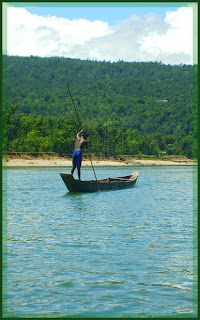Nestled in the picturesque Surma Valley amidst scenic tea plantations and lush green tropical forests, Sylhet is a prime attraction for all tourists visiting Bangladesh. Lying between the Khasia and the Jaintia hills on the north, and the Tripura hills on the south, Sylhet breaks the monotony of the flatness of this land by a multitude of terraced tea gardens, rolling countryside and the exotic flora and fauna. Here the thick tropical forests abound with many species of wild life, scented orange groves and luxuriant pineapple plantations spread their aroma around the typical hearth and homes of the Manipuri Tribal maidens famous for their dance.
Women carrying freshly plucked tea leaves through the valley
The Sylhet valley is formed by a beautiful, winding pair of rivers named the Surma and the Kushiara both of which are fed by innumerable hill streams from the north and the south. The valley has a good number of haors which are big natural depressions. During winter these haors are vast stretches of green land, but in the rainy season they turn into a turbulent sea. These haors provide a sanctuary to the millions of migratory birds who fly from across the Himalayas to escape the severe Siberian winters. Sylhet has also a very interesting and rich history. Before the conquest by the Muslims, it was ruled by local chieftains. In 1303, the great Saint Hazrat Shah Jalal came to Sylhet from Delhi with a band of 360 disciples to preach Islam and defeated the then Raja Gour Gobinda, Sylhet thus became a district of saints, shrines and daring but virile people.
Its rich potentialities became easily attractive and the 18th century Englishmen made their fortune in tea plantation. About 80 km. from Sylhet town connected by road and rail, Srimangal, which is known as the tea capital of Bangladesh, is the actual tea centre of the area. For miles and miles around, the visitor can see the tea gardens spread like a green carpet over the plain land or on the sloping hills. A visit to the tea plantation in Sylhet is a memorable experience. Sylhet, the tea granary of Bangladesh, not only has over 150 tea gardens but also proudly possesses three largest tea gardens in the world both in area and production.
Its rich potentialities became easily attractive and the 18th century Englishmen made their fortune in tea plantation. About 80 km. from Sylhet town connected by road and rail, Srimangal, which is known as the tea capital of Bangladesh, is the actual tea centre of the area. For miles and miles around, the visitor can see the tea gardens spread like a green carpet over the plain land or on the sloping hills. A visit to the tea plantation in Sylhet is a memorable experience. Sylhet, the tea granary of Bangladesh, not only has over 150 tea gardens but also proudly possesses three largest tea gardens in the world both in area and production.



























